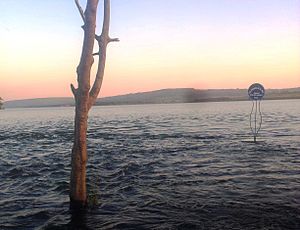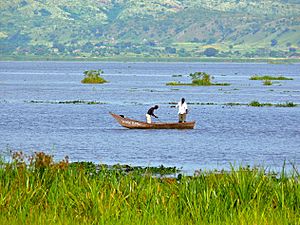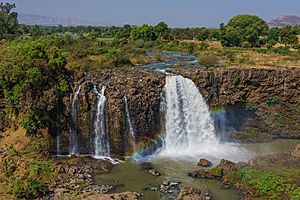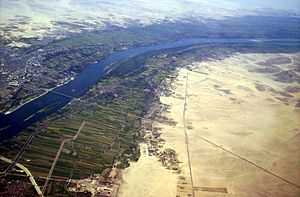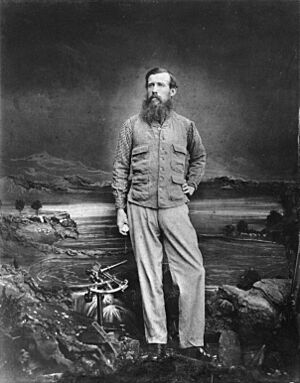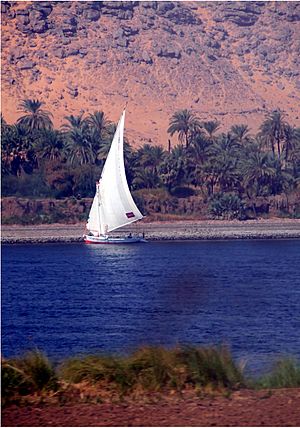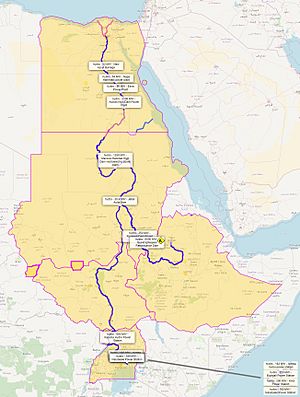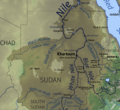Nile facts for kids
Quick facts for kids Nile |
|
|---|---|

Nile in Cairo, Egypt
|
|
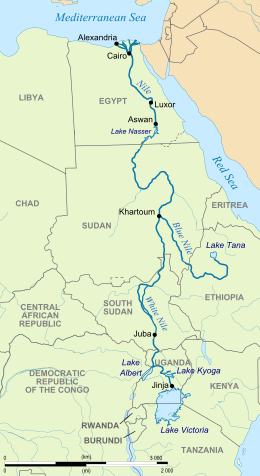 |
|
| Countries | Egypt, Sudan, South Sudan, Ethiopia, Uganda, Democratic Republic of the Congo, Kenya, Tanzania, Rwanda, Burundi |
| Major cities | Jinja, Juba, Khartoum, Cairo |
| Physical characteristics | |
| Main source | White Nile 2,400 m (7,900 ft) 02°16′56″S 29°19′53″E / 2.28222°S 29.33139°E |
| 2nd source | Blue Nile Lake Tana, Ethiopia 12°02′09″N 037°15′53″E / 12.03583°N 37.26472°E |
| River mouth | Mediterranean Sea Nile Delta, Egypt Sea level 30°10′N 31°09′E / 30.167°N 31.150°E |
| Length | 6,650 km (4,130 mi) |
| Width |
|
| Depth |
|
| Discharge (location 2) |
|
| Discharge (location 3) |
|
| Basin features | |
| Basin size | 3,349,000 km2 (1,293,000 sq mi) |
| Tributaries |
|
The Nile is a very important river in northeastern Africa. It flows north and empties into the Mediterranean Sea. The Nile is the longest river in Africa. For a long time, it was thought to be the longest river in the world. However, some studies now suggest the Amazon River might be a bit longer.
The Nile is about 6,650 km (4,130 mi) long. Its drainage basin (the area of land where water flows into the river) covers eleven countries. These countries are the Democratic Republic of the Congo, Tanzania, Burundi, Rwanda, Uganda, Kenya, Ethiopia, Eritrea, South Sudan, Republic of the Sudan, and Egypt. The Nile is the main water source for Egypt, Sudan, and South Sudan. It is also very important for farming and fishing in these areas.
The Nile has two main branches: the White Nile and the Blue Nile. The White Nile is usually seen as the river's starting point. But the Blue Nile actually provides most of the water downstream. It carries 80% of the water and silt (fine dirt).
The White Nile is longer and starts in the Great Lakes region. It begins at Lake Victoria and flows through Uganda and South Sudan. The Blue Nile starts at Lake Tana in Ethiopia. It flows into Sudan from the southeast. These two rivers meet in Khartoum, the capital of Sudan.
The northern part of the river flows through the Nubian Desert to Cairo. It then forms a large delta (a triangular land area) before flowing into the Mediterranean Sea at Alexandria. Ancient Egyptian and Sudanese civilizations have always relied on the Nile. Its yearly floods were very important. Most people and cities in Egypt are found along the Nile valley, especially north of the Aswan Dam. Many famous Ancient Egyptian sites are also along the river.
Contents
What's in a Name?
The names "White Nile" and "Blue Nile" come from Arabic. They describe the parts of the river that meet in Khartoum.
In ancient Egyptian language, the Nile was called Ḥ'pī or Iteru, meaning "river". The English name "Nile" comes from the Latin Nilus and Ancient Greek Neilos.
Where the Nile Flows
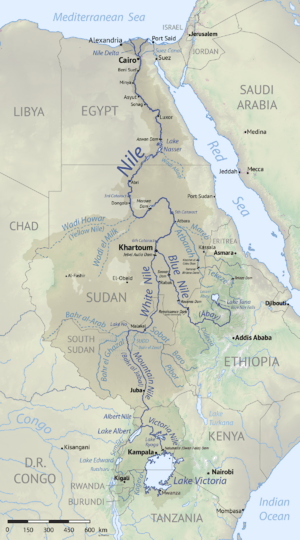
The Nile is one of the longest rivers on Earth, about 6,650 km (4,130 mi) long. Its drainage basin covers about 10% of Africa. However, the Nile carries less water than some other big rivers. For example, it carries only 5% of the water compared to the Congo River.
South of Khartoum, the river is known as the White Nile. At Khartoum, the Blue Nile joins it. The White Nile starts in East Africa, and the Blue Nile begins in Ethiopia. Both branches are on the western side of the East African Rift.
Where the Nile Begins
The Blue Nile starts at Lake Tana in the Ethiopian Highlands.
The exact source of the White Nile is still debated. The most distant source that is definitely part of the White Nile is the Kagera River. The Kagera River has smaller streams that could be the very farthest source. Some of these start in Burundi, like the Ruvyironza River and the Rurubu River. In 2010, explorers found a new source in Rwanda, making the Nile even longer.
The Nile in Uganda
The White Nile leaves Lake Victoria at Ripon Falls near Jinja, Uganda. Here, it is called the "Victoria Nile." It flows north to Lake Kyoga. Then it flows west and north through Murchison Falls to Lake Albert. After leaving Lake Albert, it continues north through Uganda as the Albert Nile.
The Nile in South Sudan
The White Nile enters South Sudan near Nimule. Here, it is called the Bahr al Jabal (meaning "Mountain River"). The Bahr al Ghazal joins the Bahr al Jabal at Lake No. After this, the river is called the Bahr al Abyad, or White Nile. It gets its name from the whitish clay in its water.
A lot of the Nile's water is lost in the huge Sudd swamp in South Sudan due to evaporation. The White Nile then meets the Sobat River at Malakal. During the dry season, the White Nile provides most of the Nile's water.
The Nile in Sudan
Below Renk, the White Nile enters Sudan. It flows north to Khartoum, where it meets the Blue Nile.
In Sudan, the Nile flows over six groups of cataracts (rocky rapids). The river also makes a big 'S' shape bend before flowing north again. In northern Sudan, the river enters Lake Nasser, a large lake that is mostly in Egypt.
The Nile in Egypt
Below the Aswan Dam, the Nile flows through Egypt. North of Cairo, the Nile splits into two main branches. These are the Rosetta Branch to the west and the Damietta Branch to the east. They form the Nile Delta before flowing into the Mediterranean Sea.
Nile's Main Branches
The Atbarah River
The Atbarah River, also called the Red Nile, is the only major branch that joins the Nile after the Blue Nile. It starts in Ethiopia and is about 800 kilometers (500 mi) long. The Atbarah only flows when there is rain in Ethiopia. It often dries up completely during the dry season.
The Blue Nile
The Blue Nile starts from Lake Tana in the Ethiopian Highlands. It flows about 1,400 kilometers to Khartoum. There, it joins the White Nile to form the main Nile River.
Most of the water (90%) and almost all the silt (96%) in the Nile comes from Ethiopia. About 59% of the water comes from the Blue Nile itself. The Blue Nile carries a lot of silt during Ethiopia's rainy season. This is when there is heavy rainfall in the Ethiopian Highlands. During the dry season, the Blue Nile can almost dry up.
The amount of water in the Blue Nile changes a lot throughout the year. This causes the main Nile's flow to vary greatly. Before dams were built, the Nile's water level at Aswan could change by 15 times between the dry and wet seasons.
Bahr el Ghazal and Sobat River
The Bahr al Ghazal and the Sobat River are two other important branches of the White Nile.
The Bahr al Ghazal has a very large drainage basin, but it adds only a small amount of water to the Nile. This is because a lot of water is lost in the Sudd wetlands.
The Sobat River joins the Nile a short distance below Lake No. It adds a lot of water to the Nile, especially when it floods. When it floods, the Sobat carries a lot of sediment, which makes the White Nile look even whiter.
The Nile's Long History
The Nile has been essential for civilization in Egypt since the Stone Age. Most of Egypt's population and cities grew along the Nile valley. The Greek historian Herodotus called Egypt "the gift of the Nile."
The river used to flood every year, leaving behind new layers of fertile silt. This made the land around the Nile very good for farming. Ancient Egyptians grew and traded wheat, flax, and papyrus. Wheat was especially important in the Middle East because it helped prevent famine. Trading along the Nile helped Egypt build relationships with other countries and kept its economy strong.
The Nile was also a great way to travel and move goods. Water buffalo and camels were brought to Egypt. These animals were used for meat, farming, and carrying things.
The Nile was also important in ancient Egyptian beliefs. Hapi was the god of the annual floods. Egyptians believed the Nile was a path from life to death and the afterlife. They thought the east side of the river was for life and growth, and the west side was for death. This is why all tombs were built west of the Nile.
The ancient Egyptian calendar was even based on the Nile's cycles. It had three seasons: Akhet (flooding), Peret (growing), and Shemu (harvest).
Searching for the Source
For a long time, people in Europe did not know where the Nile began. Many expeditions tried to find its source but failed. Ancient Greeks and Romans knew about the Blue Nile's source in Ethiopia. But the White Nile's upper parts were a mystery because of the difficult Sudd wetlands.
In the 14th century, European travelers started to hear about the Nile's source in Ethiopia. Later, in the 15th and 16th centuries, explorers visited Lake Tana and the Blue Nile's source. The Jesuit priest Pedro Páez is often given credit for being the first European to visit the Blue Nile's headwaters.
The White Nile remained a mystery for much longer. Modern exploration of the Nile basin began in the 1800s. In 1858, British explorer John Hanning Speke was the first European to see Lake Victoria. He believed he had found the source of the Nile and named the lake after Queen Victoria. Another explorer, Henry Morton Stanley, later confirmed Speke's discovery.
The Nile Today
The Nile has always been used to transport goods. Winds blow south, upriver, so ships could sail upriver and float downriver. Today, most Egyptians still live in the Nile valley.
The Aswan Dam, completed in 1970, stopped the yearly summer floods. This changed farming practices because the floods no longer brought fertile soil. However, the Nile still supports many people in Egypt, allowing them to live in parts of the Sahara desert that would otherwise be too dry.
The river has several cataracts (rapids) that make it hard for boats to travel. The Sudd swamp also makes navigation difficult.
Many cities are on the Nile, including Khartoum, Aswan, Luxor, and Cairo. The first cataract is at Aswan, north of the Aswan Dam. This part of the river is popular for tourists, with cruise ships and traditional wooden sailing boats called feluccas.
In the 1980s, a drought caused widespread hunger in Ethiopia and Sudan. But Egypt was saved by the water stored in Lake Nasser, which is behind the Aswan Dam. Droughts have caused many deaths in the Nile basin.
Sharing the Water
The Nile's water has caused disagreements between countries in East Africa and the Horn of Africa. For example, Egypt and Ethiopia have been arguing over the Grand Ethiopian Renaissance Dam. This dam is being built in Ethiopia and could affect the amount of water flowing to Egypt.
Countries like Uganda, Sudan, Ethiopia, and Kenya have complained that Egypt controls too much of the Nile's water. The Nile Basin Initiative is an effort to help these countries work together peacefully.
Several attempts have been made to create agreements on how to share the Nile's water. In 2010, Ethiopia, Rwanda, and Tanzania signed a new agreement, but Egypt and Sudan strongly opposed it. It is important for these countries to agree on how to use the Nile's water fairly. If they don't, there could be conflicts in the future.
Modern Expeditions
White Nile Journeys
In 1951, American John Goddard and two French explorers were the first to travel the entire length of the Nile. They went from its source in Burundi to the Mediterranean Sea, a journey of about 6,800 km (4,200 mi).
In 2004, the White Nile Expedition, led by South African Hendrik Coetzee, also traveled the White Nile's entire length. They started at Lake Victoria in Uganda and reached the Mediterranean Sea four and a half months later.
Blue Nile Journeys
In 2004, geologist Pasquale Scaturro and filmmaker Gordon Brown were the first known people to go down the entire Blue Nile. They traveled from Lake Tana in Ethiopia to the Mediterranean Sea. Their journey of about 5,230-kilometre (3,250 mi) took 114 days.
In 2005, Canadian Les Jickling and New Zealander Mark Tanner completed the first human-powered trip down Ethiopia's Blue Nile. Their journey of over 5,000 kilometres (3,100 mi) took five months. They faced many challenges, including traveling through war zones and areas known for bandits.
Images for kids
-
Nile Delta from space
-
An ancient map based on Herodotus' description of the world, circa 450 BC
Error: no page names specified (help). In Spanish: Nilo para niños
In Spanish: Nilo para niños


